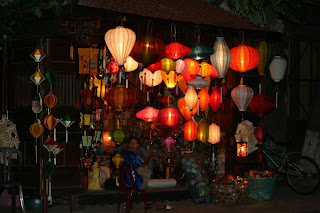Halong Bay, Vietnam, 30 June 2008
 Having learnt our lessons in Phnom Penh and Saigon we were determined not to get bogged down in Hanoi for any longer than was absolutely necessary. First stop - Ho Chi Minh Mausoleum. The guy had asked to be cremated but against his wishes he lies here in a glass case while millions (and I mean millions) of people file past. I doubt he is going to do anything about it at this stage. We were agog at the number of people here, it really was astounding. Then there is the argument "is he real or was Madam Tussuad's given a covert operation?" Either way, it is a must do (I guess) if passing through Hanoi. Next we set about booking a trip to Halong Bay...leaving tomorrow preferably. We opted for a 2 day/1 night trip. You could pay as little as 30 dollars but we had heard a few horror stories concerning the lower end options so we plumped for a bit more comfort and that's precisely what we got. We checked out of our dingy little hotel in Hanoi the following morning and were met by our bright and cheerful guide Son. His English was good and it didn't take us long to feel we had made a good choice.
Having learnt our lessons in Phnom Penh and Saigon we were determined not to get bogged down in Hanoi for any longer than was absolutely necessary. First stop - Ho Chi Minh Mausoleum. The guy had asked to be cremated but against his wishes he lies here in a glass case while millions (and I mean millions) of people file past. I doubt he is going to do anything about it at this stage. We were agog at the number of people here, it really was astounding. Then there is the argument "is he real or was Madam Tussuad's given a covert operation?" Either way, it is a must do (I guess) if passing through Hanoi. Next we set about booking a trip to Halong Bay...leaving tomorrow preferably. We opted for a 2 day/1 night trip. You could pay as little as 30 dollars but we had heard a few horror stories concerning the lower end options so we plumped for a bit more comfort and that's precisely what we got. We checked out of our dingy little hotel in Hanoi the following morning and were met by our bright and cheerful guide Son. His English was good and it didn't take us long to feel we had made a good choice.  We had a good sized double cabin on board the Phoenix Cruiser with an en-suite, 2 large windows and our own private deck chair/lounging area out front. But whatever the boat was like it soon paled in comparison to the majestic beauty of Halong Bay. As I sat on the front of the boat i thought "how are we going to describe the beauty of this place in words?" Then I read the Lonely Planets description and that seemed to capture it nicely. "Majestic and mysterious, inspiring and imperious, words alone cannot do justice to the natural wonder that is Halong Bay where 3000 or more incredible islands rise from the emerald waters of the Gulf of Tonkin. Halong Bay is pure art, a priceless collection of unfinished sculptures hewn from the hand of nature". It felt like a land before time. If living dinosaurs were to be found anywhere they would be found here.
We had a good sized double cabin on board the Phoenix Cruiser with an en-suite, 2 large windows and our own private deck chair/lounging area out front. But whatever the boat was like it soon paled in comparison to the majestic beauty of Halong Bay. As I sat on the front of the boat i thought "how are we going to describe the beauty of this place in words?" Then I read the Lonely Planets description and that seemed to capture it nicely. "Majestic and mysterious, inspiring and imperious, words alone cannot do justice to the natural wonder that is Halong Bay where 3000 or more incredible islands rise from the emerald waters of the Gulf of Tonkin. Halong Bay is pure art, a priceless collection of unfinished sculptures hewn from the hand of nature". It felt like a land before time. If living dinosaurs were to be found anywhere they would be found here.
 We spent our first day exploring caves, kayaking to secret lagoons and jumping off the boat into the warm, Gulf of Tonkin, waters. The second day we spent entirely on the boat meandering our way slowly and silently through the waters of Halong Bay before, alas, arriving at the pier in Halong town and our awaiting shuttle bus back to Hanoi. We had thought that Halong Bay would be to water what Saigon is to roads - traffic mayhem, but that wasn't the case. Sure, where we moored for the night there were plenty of boats but as we were sailing we only passed a handful of other vessels. I won't go on but will finish by saying that Halong Bay should be a "must-visit" on everyone's itinerary.
We spent our first day exploring caves, kayaking to secret lagoons and jumping off the boat into the warm, Gulf of Tonkin, waters. The second day we spent entirely on the boat meandering our way slowly and silently through the waters of Halong Bay before, alas, arriving at the pier in Halong town and our awaiting shuttle bus back to Hanoi. We had thought that Halong Bay would be to water what Saigon is to roads - traffic mayhem, but that wasn't the case. Sure, where we moored for the night there were plenty of boats but as we were sailing we only passed a handful of other vessels. I won't go on but will finish by saying that Halong Bay should be a "must-visit" on everyone's itinerary.






































